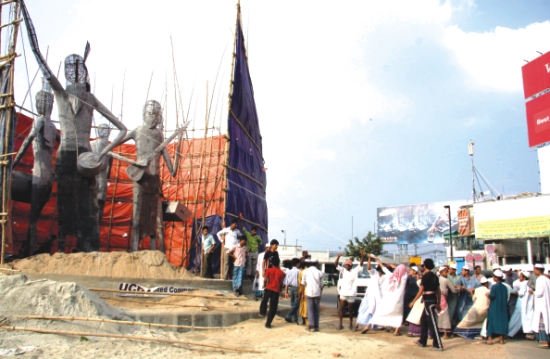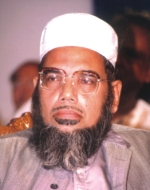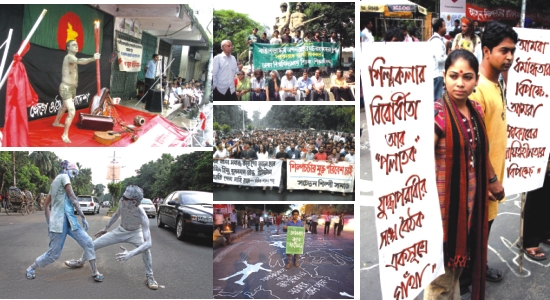|
Perceptions
Advocating Madness
Elita Karim

Bigots force the removal of the sculptures.
When, at a press conference following the demolition of the baul sculptures, the convener of the Islami Ain Bastabayan Committee, Mufti Fazlul Haque Amini, also the chairperson of Islami Oikya Jote, declared that very soon all the statues and sculptures in the country would be demolished, the freedom-loving people of the country were outraged. Images of a slow and steady destruction and forced abandonment of a rich cultural heritage began to play and replay in everyone's minds, especially when news poured in of religious bigots halting a concert which was to be performed by the famous folk singer Mumtaz, around the same time the sculptures were destructed.

Mufti Fazlul Haque Amini |
Amini, of course, used the platform to place tons of other demands and complaints, the usual tirade like demanding the expulsion of a teacher of an American college, Dr Taj Hashmi and asking that he be declared 'anti-Islam', that he be expelled from Bangladesh for his writings in a Bangla daily, scrapping of the Women's Development Policy 2008, demanding not to hand over control of the country's primary education to Brac, besides the demolition of statues built by Sheikh Hasina-led past government, once an Islamic government is formed of course. One cannot blame Amini for his dreams of building an 'ideal Bangladesh'.
They have further remarked in a confident manner, that emergency rules will not put an end to their activities. However, not only have their activities created a bigger distance between religion and the common people, they have also openly shown to the world a distorted, violent image of Islam. They have presented Islam as a religion that promotes intolerance, bigotry, bloodshed and inequality, which is quite the contrary of what the religion preaches.
A news report, on the Turkish Daily News, very recently wrote about the researches done by a famous religious scholar, Makki, according to which the Quran specifies no specific injunction against the making of statues. He says that in Sura 34, verse 13, of the Quran, statues are mentioned in a favourable manner, made for the Prophet Solomon by the Jinn -- They (the Jinn) made for him what he willed, palaces and statues, basins like wells and boilers built into the ground. Even though, Sura 5, verse 90 in the Quran clearly prohibits, as elsewhere in the Koran, idolatry, (Believers, wine and games of chance, idols and divining arrows are abominations devised by Satan), according to Makki's researches, if a statue is made, not for worship but for other reasons, and is not treated as an idol, then it is clear that there is no prohibition of sculpture in the Quran. According to Makki, in the early periods of Islam, people were not confused between sculptures and idols. It was only much later that the confusion between the two ideas came about. The same news report mentions the historian Abu al Hassan 'Ali al Masudi who recounts how in 896 AD, a large brass statue of a Hindu Goddess, brought to Baghdad was exhibited on certain days to the population of Baghdad, drawing large crowds. It seems evident that without the intent to worship, statues of themselves, even those of goddesses, were not defaced or smashed but were instead regarded with interest by the population in the capital of the Abbasid Caliphate.
Other than Makki, there are hundreds of other scholars as well who have done similar researches and come up with the same results. Promising bloodshed on the streets by the so-called Islamic leaders will neither help their so-called fight to establish an Islamic state nor will it have any meaning to the common man. Instead, research should be encouraged to learn more about a religion, Islam in this case, which seems to hold much more than what has been shown to us or taught to us.
Unfortunately, the demolition act probably had much more to do with gaining political power rather than dealing with religious extremism. Last week, many cultural activists said that the installation of "low-quality sculptures" at the airport intersection and their removal under pressure from fundamentalists was a “stage-managed drama" to abet fanatics in their conspiracy to destroy the country's arts and culture.
There is no way one can deny the significance of baul traditions of Bangladesh that includes the acetic lifestyle of these mystical men and the spiritual essence of their music that has been inspiring millions for centuries. Maqsoodul Haque, a well known musician, who has extensively researched the baul history of Bangladesh, writes in his book 'Bauliana' published from Inmark in June 2007, about Fakir Lalon Shah's (known as Shaiji to his followers), date of birth still being a mystery. He writes that at the time of his 'departure from planet earth' - he was well over 100 years of age. In as much as proofs of physical dates, place of birth or his 'religion' is concerned, Lalon Shah remains enigmatic and many mysteries surrounded him then, as much as they do now. The news of the demolition of the baul sculptures was a devastating blow to the followers of Lalon Shah, and that too around the same time when followers and admirers were observing his 118th death anniversary. Maqsood, the first one in the rock fraternity to have associated himself closely with the bauls, says that it is not in the teaching of Lalon Shah to make a great noise. “It is not in his teaching to gang up together, to destroy monuments statues and idols, or seek to harm or kill fellow man as a means - or form of protest,” he says. “I believe that deep knowledge is the only way out of the mess we are in,” he says.
 |
While cultural activists, students, and artists come together to protest the demolition of the sculptures, religious fanatics on the other hand demand the removal of all sculptures in the country. |
 |
On the other hand, several protests erupted all over the country since the demolition. Cultural personalities, students and several others have been forming human chains, organising musical shows and silent marches in Dhaka, Chittagong, Rajshahi, Bogra, Magura, Moulvibazar, Manikganj, Kushtia, Brahmanbaria, Tangail and in many more places. Immediately after the demolition of the sculptures, musicians got together at the Institute of Art, Dhaka University, popularly known as Charukala and protested against the heinous act. “For as long as we are alive, we will sing, dance and create art,” said singer, lyricist and filmmaker Krishnokoli. “That is how we define ourselves as being Bangladeshis.” Some of the other musicians who had come together to protest at the three-day show were Maqsoodul Haque, Buno, Anusheh, bands like Warfaze and many more.
Bringing down the baul sculptures also proves that during a crisis, people in this country will unite and come together to fight bigotry and anything that will deny them the right to identify with their glorious culture and snatch away their freedom to think as reasonable human beings.
Copyright
(R) thedailystar.net 2008 |
|
